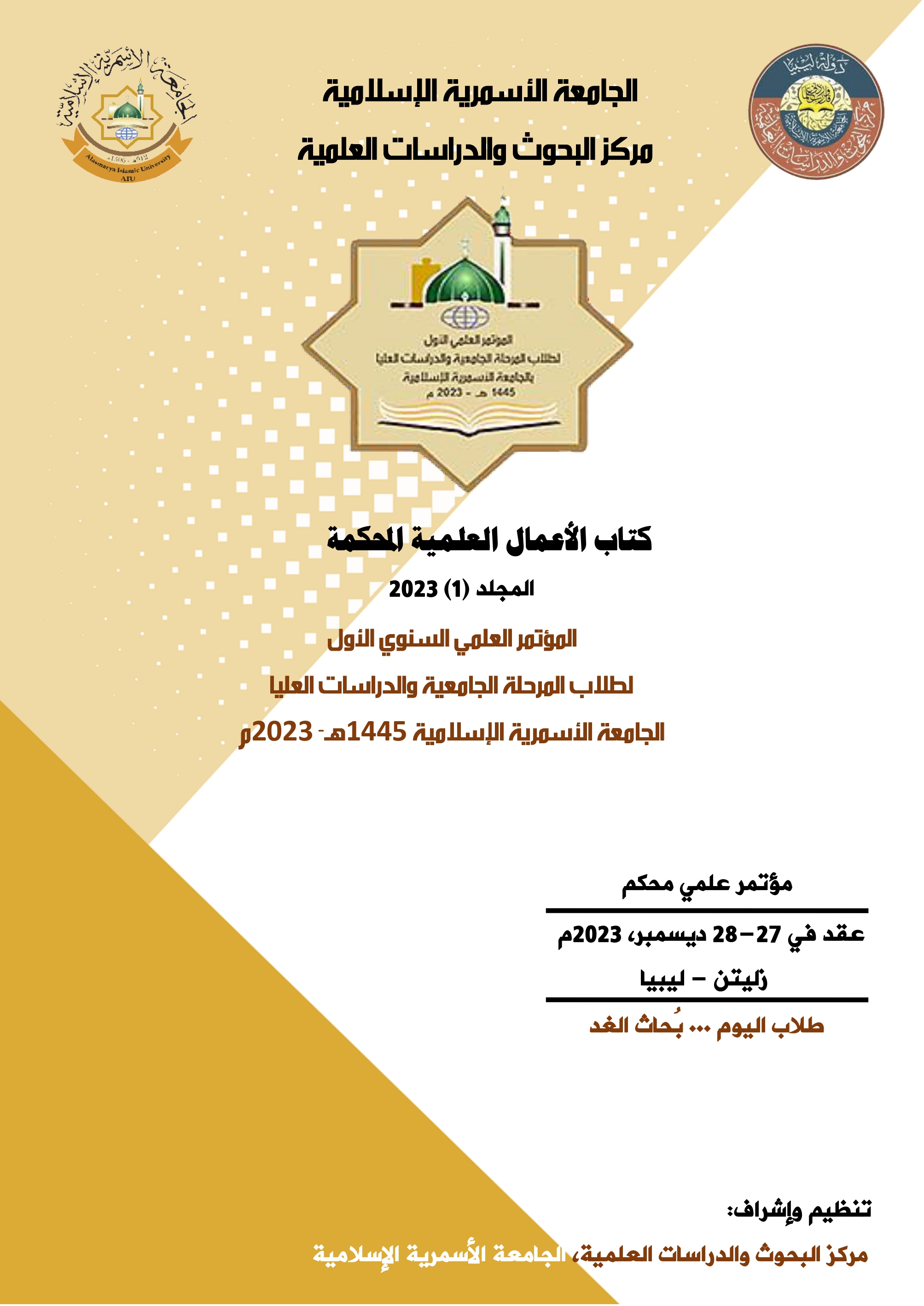تطوير نظم المعلومات في المؤسسات التعليمية: إنشاء نظام إلكتروني لتسديد الرسوم الدراسية للطالب بمدرسة مناهل الشام للتعليم والتدريب والتكوين بزليتن أنموذجاً
الكلمات المفتاحية:
النظام، المعلومات، نظم المعلومات، نظم المعلومات المحوسبة، المؤسسات التعليميةالملخص
تكمن مشكلة البحث في تحويل النظام اليدوي إلى نظام إلكتروني باستخدام الحاسوب في مدرسة مناهل الشام للتعليم والتدريب والتكوين بمدينة زليتن بحيث تكمن الصعوبة في تخزين معلومات الرسوم الدراسية والحصول على تقارير دقيقة، وكذلك استغراق الوقت في ترتيب المعلومات عند كتابة المعلومات يدوياً، وكذلك صعوبة الوصول إليها بسرعة عند الحاجة أو احتمالية ضياع المعلومات بسبب سوء التخزين، لذا هدفت الدراسة إلى تطوير النظام المعلوماتي المالي القائم بالمدرسة قيد الدراسة بحيث تجعل النظام قابل للاستخدام، والانتقال من الأسلوب الورقي التقليدي عند عملية دفع الرسوم الدراسية إلى الأسلوب الإلكتروني باستخدام الحاسوب، وتوفير الجهد المستغرق لتدوين الرسوم والمستحقات من قبل المسؤول، والحصول على تقارير دقيقة عن الرسوم والمستحقات والطلبة المسجلين والصفوف وتوفير للوقت والجهد في الحصول عليها، والحفاظ على سرية المعلومات والسماح لذوي الاختصاص فقط في الاطلاع والإضافة والتعديل والحذف على هذه المعلومات، وقد استخدمت الدراسة منهجية نموذج الشلال، واعتمدت الدراسة على الأسلوب الكائني لتحليل النظام، وتم استخدام أسلوب المقابلة الشخصية والملاحظة المباشرة والوثائق لجمع البيانات. وتوصلت الدراسة إلى مجموعة من النتائج وهي: سهولة عمليات البحث والتعديل وتخزين البيانات والحصول على التقارير (تقرير عن أسماء الطلبة المسجلين، تقرير عن الرسوم الدراسية، تقرير عن الصفوف الدراسية، تقرير عن الطلبة الذين عليهم مستحقات، تقرير عن الطلبة حسب الجنسية). كما أن النظام الذي تم تطويره يوفر الوقت والجهد وأيضاً المرونة والراحة في العمل والمحافظة على المعلومات من الضياع، ويوفر الوقت في البحث عن المعلومة، واكتساب خبرة أكبر في مجال تحليل وتصميم النظم والبرمجة لغرض تطوير الأنظمة. كما توصلت الدراسة إلى مجموعة من التوصيات أهمها؛ توفير جهاز حاسوب مناسب لتشغيل النظام من قبل الجهة المستفيدة، والاحتفاظ بنسخ احتياطية من النظام على وسائط تخزينية خارجية، وربط النظام الإلكتروني مع موقع المدرسة على شبكة الأنترنت.
التنزيلات
المراجع
أولاً: قائمة المراجع باللغة العربية
أبو عياش، عبير (2020). طريقة استخدام الفوتوشوب. تاريخ الاسترداد أبريل، 2021، من موضوع [https://mawdoo3.com /].
اصميدة، ليلى؛ العاتي، مريم؛ احميد، دعاء؛ قراطم، ايناس؛ والترهوني، إيمان (2021). توظيف تقنية المعلومات في تطوير العملية التعليمية في مؤسسات التعليم العالي: تطبيق أندرويد للإرشاد الأكاديمي أنموذجاً. المجلة الليبية لعلوم التعليم، 4(1)، 15-40.
الأنباري، عمار (2018). الربط بين قواعد البيانات والفيجوال استيديو. دار المناهج للنشر، عمان، الأردن.
بسيوني، عبد الحميد (2005). أساسيات هندسة البرمجيات. دار الكتب العلمية للنشر والتوزيع، القاهرة.
جابر، ألاء (2019). وسائل جمع البيانات في البحث العلمي. تاريخ الاسترداد يونيو، 2021، من موضوع [https://mawdoo3.com /].
رجب، عبد الحميد (2010). تصميم وبناء مشاريع نظم المعلومات باستخدام هندسة البرمجيات. دار خوارزم العلمية،
السالمي، علاء (2007). نظم إدارة المعلومات. المنظمة العربية للتنمية الإدارية، القاهرة.
الشيباني، فتحي أحمد (2006). نظام المعلومات المالي في الشركة الليبية للحديد والصلب: دراسة تحليلية. رسالة ماجستير، الأكاديمية الليبية-فرع مصراته، مصراته، ليبيا.
الصويعي، ميسرة (2007). فاعلية تحليل النظم في بناء قواعد البيانات في اللجنة الشعبية لمصلحة الجمارك، رسالة ماجستير، الأكاديمية الليبية، طرابلس، ليبيا.
عليان، ربحي (2011). نظم وشبكات المعلومات الأنترنت نموذجاً. مجلة العربية، 5(1)،30-45.
فتحي، عهد موفق؛ علي، زهراء أحمد (2022). تصميم نظام محوسب لإدارة مكتبة: نموذج مقترح لمكتبة كلية الإدارة والاقتصاد. بحث بكالوريوس، جامعة الموصل، الموصل، العراق.
قنديلجي، عامر؛ عليان، ربحي؛ السامرائي، ايمان (2009). مصادر المعلومات التقليدية والإلكترونية. دار اليازوري العلمية للنشر والتوزيع، عمان، الأردن.
محروس، عارف (2021). التحول الإلكتروني وتطوير نظام المعلومات الحكومي المصري: دراسة ميدانية. مجلة البحوث المالية والتجارية، 22(3)، 1019-1078.
ياسين، سعد (2005). تحليل وتصميم نظم المعلومات. دار المناهج للنشر والتوزيع، عمان، الأردن.
ثانياً: قائمة المراجع باللغة الإنجليزية
Gharajeh, M. S. (2019). Waterative Model: An Integration of the Waterfall and Iterative Software Development Paradigms. Database Systems Journal, 13(1), 75-81.
التنزيلات
منشور
إصدار
القسم
الرخصة
الحقوق الفكرية (c) 2023 نعيمة هيبلو محمد المصري، حنان عبد السلام علي سليم، صفاء عطية إبراهيم شلغو، بثينة على ميمون الجميل، عبير عطية محمد الكوشي

هذا العمل مرخص بموجب Creative Commons Attribution 4.0 International License.





